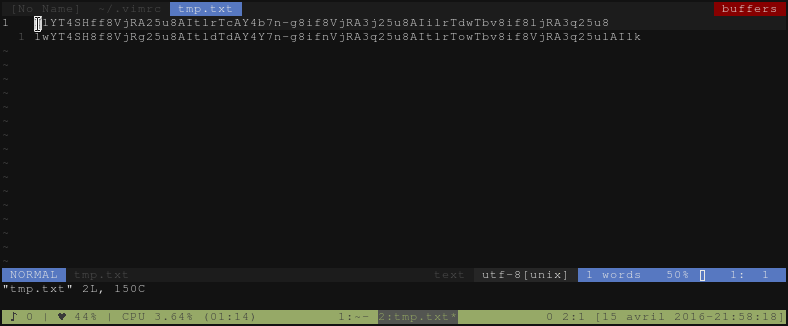This solution doesn't show the difference between the two lines but highlight them and allow you to navigate through them with n and N like this:

To do so add this function to your .vimrc:
function! CompareLines(line1, line2)
let l1 = getline(a:line1)
let l2 = getline(a:line2)
let pattern = ""
for i in range(strlen(l1))
if strpart(l1, i, 1) != strpart(l2, i, 1)
if pattern != ""
let pattern = pattern . "\\|"
endif
let pattern = pattern . "\\%" . a:line1 . "l" . "\\%" . ( i+1 ) . "c"
let pattern = pattern . "\\|" . "\\%" . a:line2 . "l" . "\\%" . ( i+1 ) . "c"
endif
endfor
execute "let @/='" . pattern . "'"
set hlsearch
normal n
endfunction
You can call the function with :call CompareLines(1, 2) where the arguments are the numbers of the lines to compare.
To add a bit more details about how the function works:
The first lines gets the lines to compare in some variables.
The loop iterates through these strings. Each characters of the strings are compared and when they don't match a pattern of the form \%Xl\%Yc is added to the variable pattern where X and Y are the line and the column of a character.
(See :h /ordinary-atom and especially the last lines which explains that the pattern \%23l allows to match the 23rd line and \%23c the 23rd column)
Once the pattern is build it is injected in the search register (let @/= allow to define the content of the register and the pattern has to be quoted).
Finally set hlsearch is used to highlight all the matches of the pattern and normal n brings the cursor to the first different character.
Note 1 The function will change your search history.
Note 2 The part which uses the pattern to make the search could probably be greatly improved.
And as a bonus Add this line to your .vimrc to create a command which will faster the call of the function:
command! -nargs=* CompLines call CompareLines(<f-args>)
This way you can simple use :CompLines 1 2 to compares two lines.
EDIT And here is an improved version of the function and of the command. The difference is that you can call it in 3 different ways:
:CL will diff the current line and the following one:CL 23 will diff the current line and the line 23:CL 23 42 will diff the lines 23 and 42
Here is the code:
command! -nargs=* CL call CompareLines(<f-args>)
function! CompareLines(...)
" Check the number of arguments
" And get lines numbers
if len(a:000) == 0
let l1=line(".")
let l2=line(".")+1
elseif len(a:000) == 1
let l1 =line(".")
let l2 =a:1
elseif len(a:000) == 2
let l1 = a:1
let l2 = a:2
else
echom "bad number of arguments"
return;
endif
" Get the content of the lines
let line1 = getline(l1)
let line2 = getline(l2)
let pattern = ""
" Compare lines and create pattern of diff
for i in range(strlen(line1))
if strpart(line1, i, 1) != strpart(line2, i, 1)
if pattern != ""
let pattern = pattern . "\\|"
endif
let pattern = pattern . "\\%" . l1 . "l" . "\\%" . ( i+1 ) . "c"
let pattern = pattern . "\\|" . "\\%" . l2 . "l" . "\\%" . ( i+1 ) . "c"
endif
endfor
" Search and highlight the diff
execute "let @/='" . pattern . "'"
set hlsearch
normal n
endfunction
EDIT 2 I made it a plugin. You can install it with a regular plugin manager with (e.g.):
Plug 'statox/vim-compare-lines'
